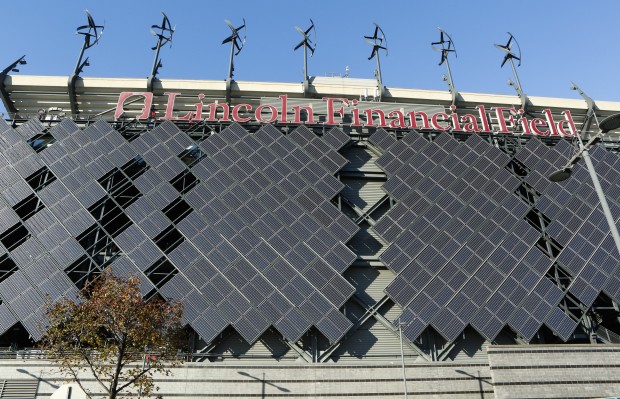DEP releases Climate Action Plan for Pennsylvania
-
Susan Phillips

Mark Stehle/Invision / NRG/AP Images
Micro-wind turbines and solar panels installed at Lincoln Financial Field in Philadelphia generate renewable energy. The state’s Climate Action Plan recommends rooftop solar and more energy efficient buildings.
Pennsylvania’s climate change action plan reports the greatest potential reductions in the state’s contribution to greenhouse gas emissions could also create new jobs and increase household income by reducing energy costs. The Department of Environmental Protection released its 2015 Climate Change Action Plan Update on Friday, which outlines the economic impact of steps the state could take to cut climate warming emissions. Organized into 13 work plans, it serves as a roadmap for reducing the state’s carbon footprint and details legislative recommendations.
Topping the list of carbon reduction strategies is making newly constructed buildings more energy efficient. The DEP recommends that new buildings be built to use 60 percent less fossil fuels on average, based on energy consumption by structures built in 2005. The DEP recommends energy consumption reductions of 80 percent in new buildings, and by 50 percent in existing buildings, by 2030. That work plan ranks 5th in terms of economic benefits.
The winner for economic gains, includes making simple, inexpensive changes to tractor trailers, such as “truck skirts” that reduce drag and help 18-wheelers become more fuel efficient. Although that plan includes the most economic gains, it has the least amount of impact regarding carbon reductions. The EPA recently announced new rules that would force the country’s trucking fleet to become more fuel efficient by 2027.
Other recommendations that would cut greenhouse gas emissions include changes to lighting, both inside and outside of buildings, heating oil conservation and fuel switching, encouraging electric distribution companies to reduce consumer demand, coal mine methane recovery, combined heat and power development, and tree-planting to help sequester carbon.
The agency outlined 12 legislative recommendations. These include increasing the state’s Alternative Energy Portfolio Standard, investing in rooftop solar, cutting consumer energy use by expanding Act 129 to smaller electric distributers as well as natural gas providers, adopting the latest in energy building codes, requiring energy-use disclosure for real estate transactions, continuing programs that finance energy conservation projects for homeowners, increasing funds for manufacturers to conduct energy audits, and funding manure digesters.
A 2008 law known as the Pennsylvania Climate Change Act directs the state Department of Environmental Protection (DEP) to publish two climate reports every three years. One is an overall climate change impact assessment. The other is an action plan for lowering greenhouse gas emissions. The macroeconomic analysis for this action plan was developed for DEP by the Center for Climate Strategies.
















